
Intrinsic value is a fundamental concept in finance and investing. It refers to the true, inherent worth of an asset, be it a stock, bond, or real estate. Understanding intrinsic value helps investors make informed decisions, guiding them towards assets that are undervalued or fairly priced.
Many investors rely on intrinsic value to assess whether an investment is worth buying. This approach contrasts with speculative investing, where decisions are based on market trends and price movements. By focusing on intrinsic value, investors aim to minimize risk and maximize returns.
In this article, we will explore what intrinsic value is, how to calculate it, and why it matters. We will also discuss different methods used to determine intrinsic value and how this concept applies to various types of investments.
What is Intrinsic Value?

Intrinsic value represents the actual worth of an asset, independent of its current market price. It is based on the asset’s fundamental characteristics, such as earnings, dividends, and growth potential. Intrinsic value is often contrasted with market value, which is the price at which an asset is currently traded.
To understand intrinsic value, it’s essential to consider the factors that influence an asset’s true worth. These factors can include cash flow, profitability, and the economic environment in which the asset operates. By evaluating these elements, investors can estimate the intrinsic value and determine whether the asset is overvalued, undervalued, or fairly priced.
The concept of intrinsic value is rooted in the idea that market prices can be influenced by various factors, including investor sentiment, speculation, and short-term events. As a result, market prices may not always reflect an asset’s true worth. Intrinsic value provides a more stable and reliable measure of an asset’s value, helping investors make more rational decisions.
Methods to Calculate Intrinsic Value

Calculating the intrinsic value of an asset is a fundamental concept in finance and investing, providing insights into whether an asset is overvalued or undervalued. Several methods are commonly used to determine intrinsic value, each with its strengths and limitations. Here, we will delve deeper into the three primary methods: Discounted Cash Flow (DCF) Analysis, Dividend Discount Model (DDM), and Relative Valuation.
Discounted Cash Flow (DCF) Analysis
DCF analysis is a comprehensive method that estimates an asset’s intrinsic value by forecasting its future cash flows and discounting them back to their present value. This method acknowledges the time value of money, which posits that a dollar today is worth more than a dollar in the future due to its earning potential.
Steps:
- Forecast Future Cash Flows: Estimate the cash flows the asset is expected to generate over a specific period.
- Determine the Discount Rate: Identify an appropriate discount rate, often the asset’s weighted average cost of capital (WACC) or required rate of return.
- Calculate Present Value: Discount the future cash flows back to their present value using the discount rate.
- Sum of Present Values: The intrinsic value is the sum of the discounted future cash flows.
Applications:
- Widely used for valuing businesses and investments with predictable and stable cash flows.
- Particularly useful for long-term investment decisions.
Limitations:
- Requires accurate forecasting of future cash flows, which can be challenging.
- Sensitive to changes in the discount rate and growth assumptions.
Dividend Discount Model (DDM)
The DDM is a valuation method specifically for stocks that pay dividends. It calculates the present value of expected future dividends, considering the dividend growth rate and the investor’s required rate of return.
Types:
- Gordon Growth Model (Constant Growth DDM): Assumes dividends will grow at a constant rate indefinitely.
- Multi-Stage DDM: Assumes different growth rates for different periods, typically a higher growth rate initially and a lower rate in perpetuity.
Applications:
- Best suited for mature companies with stable and predictable dividend payouts.
- Useful for income-focused investors.
Limitations:
- Less effective for companies that do not pay dividends or have unpredictable dividend patterns.
- Highly sensitive to the growth rate and required return assumptions.
Also Read: Trading Platform Development: Get to Know More!
Relative Valuation
Relative valuation compares an asset’s valuation metrics to those of similar assets. The most common metrics include the price-to-earnings (P/E) ratio, price-to-book (P/B) ratio, and enterprise value-to-EBITDA (EV/EBITDA).
Steps:
- Select Comparable Assets: Identify similar assets in the same industry or with similar characteristics.
- Calculate Valuation Metrics: Compute the relevant valuation metrics for the asset and its peers.
- Compare Metrics: Determine whether the asset is undervalued or overvalued relative to its peers.
Applications:
- Simplifies the valuation process by using readily available market data.
- Useful for making quick comparisons and identifying potential investment opportunities.
Limitations:
- Assumes that similar assets should be valued similarly, which may not always hold true.
- May overlook unique aspects of the asset being valued that could justify a different valuation.
Each method of calculating intrinsic value has its unique advantages and limitations. DCF analysis provides a detailed and forward-looking valuation, making it suitable for long-term investments. The DDM focuses on dividend-paying stocks, offering a straightforward approach for income investors. Relative valuation allows for quick comparisons but relies heavily on the assumption of comparable assets. Understanding these methods and their appropriate applications is crucial for making informed investment decisions and accurately assessing an asset’s true worth.
Importance of Intrinsic Value in Investing

Understanding intrinsic value is crucial for making informed investment decisions. By focusing on intrinsic value, investors can identify opportunities that the market may have overlooked. This approach helps investors avoid overpaying for assets and reduces the risk of losses.
Intrinsic value is derived from an asset’s fundamental characteristics, such as its cash flow, growth potential, and risk factors. Unlike market value, which can be influenced by investor sentiment and external factors, intrinsic value provides a more objective assessment of an asset’s worth. This objective analysis helps investors make rational decisions based on solid data rather than market hype or fear.
Long-Term Perspective
Intrinsic value also promotes a long-term investment perspective. By evaluating an asset’s true worth, investors are less likely to be swayed by short-term market fluctuations and speculative trends. This long-term focus can lead to more stable and sustainable returns over time. Investors who concentrate on intrinsic value are typically more patient and disciplined, waiting for the right opportunities to buy undervalued assets and holding them until their market value reflects their intrinsic worth.
Benchmark for Performance Evaluation
Additionally, intrinsic value serves as a benchmark for evaluating investment performance. By comparing the market price of an asset to its intrinsic value, investors can assess whether their investments are performing as expected. This comparison can also help investors make adjustments to their portfolios, reallocating funds to assets with higher intrinsic value. This process ensures that the portfolio remains aligned with the investor’s financial goals and risk tolerance.
Risk Management
Focusing on intrinsic value also aids in risk management. By understanding the fundamental value of an asset, investors can better gauge the risks associated with it. They can identify when an asset is overpriced and thus avoid potential losses when the market corrects itself. Conversely, recognizing undervalued assets allows investors to capitalize on potential gains as the market adjusts.
Enhanced Investment Strategies
Finally, incorporating intrinsic value into investment strategies enhances overall decision-making. Investors can develop more robust strategies by integrating intrinsic value analysis with other investment principles, such as diversification and asset allocation. This holistic approach ensures a balanced and well-thought-out investment plan, reducing the likelihood of emotional or impulsive decisions.
Intrinsic value is a cornerstone of prudent investing. It provides a solid foundation for making informed decisions, promotes a long-term perspective, serves as a performance benchmark, aids in risk management, and enhances overall investment strategies. By focusing on intrinsic value, investors can achieve more consistent and sustainable financial success.
Challenges in Determining Intrinsic Value
While intrinsic value is a powerful concept, it comes with several challenges that can make its determination both subjective and complex.
1. Subjectivity in Assumptions
Estimating intrinsic value requires making assumptions about future cash flows, growth rates, and discount rates. These assumptions can be highly subjective, as they are based on an investor’s perspective and analysis of future performance. Different investors may have varying expectations and risk appetites, leading to different estimates of intrinsic value for the same asset. For example, a conservative investor might use a higher discount rate to account for risk, resulting in a lower intrinsic value compared to an investor with a higher risk tolerance.
2. Complexity and Time-Consumption
Intrinsic value calculations can be intricate and time-consuming. Investors need to gather and analyze a significant amount of data, including financial statements, market conditions, and industry trends. This process requires a deep understanding of finance and accounting principles, which can be a barrier for individual investors who may lack the necessary expertise or resources. Detailed financial models and valuation techniques, such as discounted cash flow (DCF) analysis, require proficiency in financial modeling and a thorough comprehension of the underlying business.
3. Dynamic Nature of Intrinsic Value
An asset’s intrinsic value is not static; it can change over time due to various factors such as changes in the business environment, technological advancements, and regulatory developments. For instance, a new technology could disrupt an industry, significantly altering the future cash flow projections for companies within that sector. Similarly, regulatory changes could impact operational costs and profitability. Therefore, investors need to continuously monitor these factors and update their intrinsic value estimates accordingly, which adds an additional layer of complexity to the valuation process.
4. Information Quality and Availability
The accuracy of intrinsic value estimates depends on the quality and availability of information. Incomplete or inaccurate financial data can lead to incorrect valuations. For instance, companies might engage in aggressive accounting practices that obscure their true financial health. Additionally, smaller companies or those in emerging markets might not have the same level of transparency and reporting standards as larger, well-established firms. This lack of reliable information can make it difficult to accurately assess an asset’s intrinsic value.
5. Market Sentiment and Behavioral Factors
Market sentiment and investor behavior can also influence intrinsic value estimates. During periods of market exuberance or panic, investors’ assumptions about future growth and risk can be skewed by emotions rather than rational analysis. Behavioral biases, such as overconfidence or herd mentality, can lead to mispricing of assets based on unrealistic expectations. As a result, intrinsic value estimates during such times may not accurately reflect the underlying fundamentals.
Determining intrinsic value is a crucial aspect of investment analysis, but it is fraught with challenges. Subjectivity in assumptions, the complexity of calculations, the dynamic nature of value, information quality, and behavioral factors all contribute to the difficulties in accurately estimating intrinsic value. Despite these challenges, a thorough and disciplined approach to valuation can provide valuable insights and help investors make more informed decisions.
Applying Intrinsic Value in Different Investment Types
Intrinsic value can be applied to various types of investments, including stocks, bonds, and real estate. Each type of investment requires different methods and considerations for estimating intrinsic value.
- Stocks: For stocks, intrinsic value can be estimated using methods such as DCF analysis and DDM. Investors need to consider factors like earnings growth, dividend payouts, and the company’s competitive position in the market. By comparing the intrinsic value to the market price, investors can identify undervalued or overvalued stocks.
Also Read: TWAP Trading: A Strategy for Consistent Returns
- Bonds: The intrinsic value of bonds is primarily determined by their future cash flows, which include interest payments and the principal repayment. Investors use DCF analysis to discount these cash flows to their present value, considering the bond’s yield and credit risk. Bonds with higher intrinsic value relative to their market price are considered attractive investments.
- Real Estate: In real estate, intrinsic value is often estimated using income-based approaches, such as the capitalization rate method. This method calculates the value of a property based on its expected income and a required rate of return. Investors also consider factors like location, property condition, and market trends when estimating the intrinsic value of real estate.
Conclusion
Intrinsic value is a vital concept in investing, offering a more stable and reliable measure of an asset’s true worth. By focusing on intrinsic value, investors can make informed decisions, identify undervalued opportunities, and reduce the risk of losses.
Calculating intrinsic value involves various methods, such as DCF analysis, DDM, and relative valuation. Each method has its strengths and limitations, but all aim to provide a better understanding of an asset’s true worth. Despite the challenges in determining intrinsic value, the benefits of this approach make it a valuable tool for long-term investing.
Incorporating intrinsic value into investment strategies can lead to more rational and disciplined decision-making. By focusing on the true worth of assets, investors can navigate market fluctuations and speculative trends, achieving more sustainable and consistent returns over time.
Disclaimer: The information provided by Quant Matter in this article is intended for general informational purposes and does not reflect the company’s opinion. It is not intended as investment advice or a recommendation. Readers are strongly advised to conduct their own thorough research and consult with a qualified financial advisor before making any financial decisions.

Joshua Soriano
As an author, I bring clarity to the complex intersections of technology and finance. My focus is on unraveling the complexities of using data science and machine learning in the cryptocurrency market, aiming to make the principles of quantitative trading understandable for everyone. Through my writing, I invite readers to explore how cutting-edge technology can be applied to make informed decisions in the fast-paced world of crypto trading, simplifying advanced concepts into engaging and accessible narratives.
- Joshua Soriano#molongui-disabled-link
- Joshua Soriano#molongui-disabled-link
- Joshua Soriano#molongui-disabled-link
- Joshua Soriano#molongui-disabled-link
